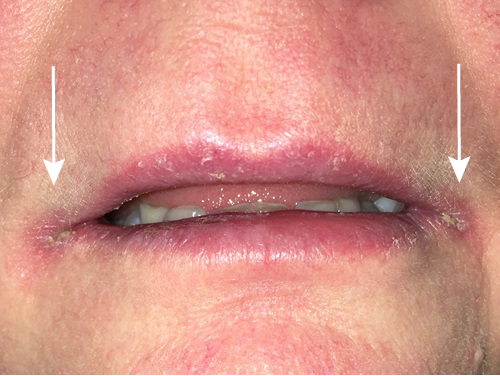Management of angular cheilitis
Angular cheilitis presents as painful erythema and fissuring of the corners of the mouth; see Angular cheilitis for a photo. It is most commonly caused by Candida and related species1 (commensal organisms of the oral cavity) and associated with Oral and oropharyngeal infection caused by Candida and related speciesFederico, 2023. Other commensal organisms can be involved, such as Staphylococcus aureus and Streptococcus species, but topical antibiotic therapy does not have adequate evidence to support its useCabras, 2019.
Predisposing factors includeFederico, 2023:
- ill-fitting dentures (or not wearing dentures)
- dry, chapped lips
- iron, folate or vitamin B deficiency
- Crohn disease
- retinoids (eg isotretinoin)
- atopic or seborrheic dermatitis.

Photo sourced with permission from Associate Professor Sue-Ching Yeoh.
Angular cheilitis often self-resolves. Address predisposing factors (eg dental review to refit dentures; removal of dentures at night; protection with petroleum jelly, emollients or lip balm if the skin is macerated). If angular cheilitis has still not resolved, use:
1clotrimazole 1% cream topically to the angles of the mouth, twice daily for 14 days clotrimazole clotrimazole clotrimazole
OR
1miconazole 2% cream topically to the angles of the mouth, twice daily for 14 days. miconazole miconazole miconazole
A mild topical corticosteroid can be used to treat the associated inflammatory dermatitis; add to the topical antifungal therapy regimen above:
hydrocortisone 1% cream topically to the angles of the mouth, twice daily until inflammation subsides. hydrocortisone hydrocortisone hydrocortisone
Combination products containing a topical corticosteroid and antifungal are available, but topical corticosteroids should only be used until inflammation subsides. If combination products are used, complete treatment with a topical antifungal alone, for 14 days total.
If oral or oropharyngeal candidiasis is also present, treat with topical antifungal therapy.
Seek specialist advice for persistent angular cheilitis that is not responsive to appropriate use of nonpharmacological and pharmacological treatments.
